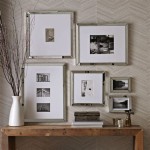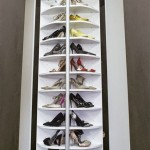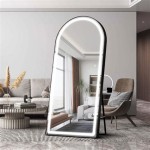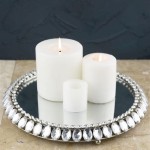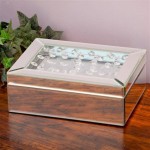Best Way to Clean A Mirror for a Streak-Free Shine
Mirrors, while essential for daily grooming and enhancing the aesthetic appeal of a space, are notorious for collecting dust, fingerprints, and water spots. Maintaining a clean mirror requires a methodical approach and the right tools to achieve a streak-free, flawless finish. This article details the most effective methods for cleaning mirrors, ensuring optimal clarity and longevity.
Regular cleaning prevents the buildup of grime that can be increasingly difficult to remove over time. Waiting too long between cleanings may necessitate more aggressive cleaning solutions and techniques, potentially damaging the mirror's surface or reflective backing. A proactive cleaning schedule, typically once or twice a month, significantly reduces the effort required and maintains the mirror's pristine condition.
Before commencing the cleaning process, it is crucial to gather the necessary supplies. The effectiveness of the cleaning hinges on using the appropriate tools and solutions designed for delicate surfaces like mirrors. Avoid abrasive cleaners or materials that could scratch or dull the mirror's reflective coating. The following items are generally recommended:
*Spray bottle
*Microfiber cloths (at least two)
*Distilled water
*White vinegar (optional)
*Rubbing alcohol (optional, for stubborn stains)
*Dish soap (optional, for heavily soiled mirrors)
*Cotton swabs (for cleaning edges and hard-to-reach areas)
Preparation is Key: Protecting the Surrounding Area
Prior to applying any cleaning solution, it is essential to protect the surrounding area from drips and overspray. Mirrors are often situated near walls, countertops, or fixtures that could be damaged by certain cleaning agents. Laying down a towel or protective sheet beneath the mirror will prevent accidental spills from staining or corroding these surfaces. This is particularly important when using solutions containing vinegar or alcohol, which can etch delicate materials.
Inspect the mirror for any loose debris, such as dust bunnies or hair, and remove them with a dry microfiber cloth or a soft brush. This preliminary step prevents the debris from smearing across the mirror's surface during the cleaning process, further complicating the task. Special attention should be paid to the edges and corners of the mirror, where dust tends to accumulate. A vacuum cleaner with a soft brush attachment can also be used to remove dust from these areas.
Before applying any cleaning solutions to the entire mirror, it is advisable to test it on a small, inconspicuous area. This allows for assessing the solution's compatibility with the mirror's surface and preventing any potential damage or discoloration. Allow the test area to dry completely before proceeding with the full cleaning process. If any adverse reactions are observed, such as streaking or dulling, the solution should be diluted or replaced with a more suitable alternative.
Effective Cleaning Solutions: From Homemade Recipes to Commercial Products
Several effective cleaning solutions can be employed to achieve a streak-free mirror. While commercial glass cleaners are readily available, homemade solutions often prove equally effective and are environmentally friendly and cost-effective. The choice of solution depends on the level of soiling and personal preferences.
Distilled Water: For lightly soiled mirrors, distilled water alone can be surprisingly effective. The key is to use a clean microfiber cloth and avoid tap water, which often contains minerals that can leave streaks. Dampen one microfiber cloth with distilled water and wipe the mirror's surface thoroughly. Immediately follow with a dry microfiber cloth to buff the surface and prevent water spots from forming.
Vinegar Solution: A mixture of equal parts distilled water and white vinegar is a popular and effective cleaning solution for mirrors. Vinegar's mild acidity helps to dissolve grease, grime, and hard water stains. Fill a spray bottle with the solution and lightly mist the mirror's surface. Allow the solution to dwell for a few seconds to loosen the dirt, and then wipe clean with a microfiber cloth. Buff dry with a second clean microfiber cloth.
Rubbing Alcohol Solution: For mirrors with stubborn stains, such as hairspray residue or sticky fingerprints, a solution of distilled water and rubbing alcohol can be used. A ratio of one part rubbing alcohol to three parts distilled water is generally recommended. Apply the solution sparingly and wipe with a clean microfiber cloth. Rubbing alcohol is an effective degreaser and evaporates quickly, reducing the likelihood of streaking.
Dish Soap Solution: For heavily soiled mirrors, a mild dish soap solution can be used. Add a few drops of dish soap to a bucket of warm water and mix thoroughly. Dip a microfiber cloth into the solution, wring out the excess water, and wipe the mirror's surface. Rinse the mirror with clean water to remove any soap residue, and then dry with a clean microfiber cloth. It is crucial to use a minimal amount of dish soap to prevent excessive suds and streaking.
When using commercial glass cleaners, it is important to choose products that are specifically designed for mirrors and glass surfaces. Avoid using cleaners that contain ammonia, as they can damage the mirror's reflective backing over time. Follow the manufacturer's instructions carefully and apply the cleaner sparingly. Over-spraying can lead to drips and streaks, requiring additional effort to achieve a clean finish.
The Technique Matters: Achieving a Streak-Free Finish
The technique employed during the cleaning process significantly impacts the final result. Even with the best cleaning solutions, improper wiping techniques can lead to streaks and an unsatisfactory outcome. The following techniques are recommended for achieving a streak-free finish:
Proper Wiping Direction: When wiping the mirror, use overlapping strokes in a consistent direction, either horizontally or vertically. Avoid swirling or circular motions, as these can leave streaks. Start at the top of the mirror and work your way down, ensuring that each section is thoroughly cleaned. Maintain a consistent pressure throughout the wiping process.
Microfiber Cloths: Use high-quality microfiber cloths specifically designed for cleaning glass surfaces. These cloths are lint-free and highly absorbent, effectively removing dirt and moisture without leaving streaks or residue. Avoid using paper towels or other abrasive materials, as they can scratch the mirror's surface.
Dry Buffing: After wiping the mirror with a damp cloth, immediately buff dry with a clean, dry microfiber cloth. This step is crucial for removing any remaining moisture and preventing water spots from forming. Use a moderate amount of pressure and ensure that the entire surface is thoroughly buffed. For larger mirrors, it may be necessary to use multiple dry cloths to achieve a streak-free finish.
Edge and Corner Detailing: Pay special attention to the edges and corners of the mirror, where dust and grime tend to accumulate. Use cotton swabs dipped in the cleaning solution to clean these hard-to-reach areas. Gently wipe away any dirt or residue, and then dry with a clean cloth. Inspect the edges and corners closely to ensure that all debris has been removed.
Troubleshooting Streaks: If streaks persist after cleaning, it may be necessary to repeat the process with a fresh microfiber cloth and a slightly diluted cleaning solution. Ensure that the mirror is completely dry before assessing the results. Stubborn streaks may require the use of a specialized glass cleaner or a polishing compound designed for mirrors. Follow the manufacturer's instructions carefully and test the product on a small, inconspicuous area before applying it to the entire mirror.
By following these guidelines, a streak-free and sparkling mirror can be achieved, enhancing the overall appearance of any space. Regular maintenance and the use of appropriate cleaning techniques will ensure that mirrors remain clean and reflective for years to come.

Best Way To Clean Mirrors On 59 Off Www Ingeniovirtual Com

How To Clean Mirror Glass Cleanipedia Ph
How To Clean Mirrors Without Streaks Chemical Free What Use Microfiber Whole

How To Clean A Mirror At Home Decor Buzz

How To Clean Mirrors Pure Home Improvement

What Is The Best Way To Clean Mirrors Without Streaking Bond Cleaningin Adelaide

Best Ways To Clean Your Mirror And Make It Shine Https Www Biggietips Com

10 Of The Best Ways To Clean A Mirror

How To Clean Mirrors Pure Home Improvement

Best Way To Clean Mirror Avoid Streaks For The Blokes

